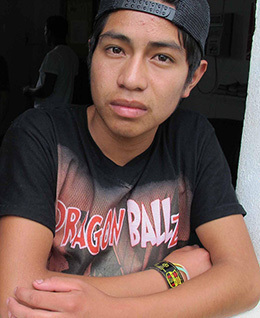A team of Notre Dame researchers set out to investigate the correlation between the social resources of Honduran youth — the ability to adapt in the face of trauma, threats, and significant sources of stress — and their migration intentions.
The findings challenge conventional wisdom that those who enjoy some form of employment and strong support networks are more inclined to attach themselves to a set geography. Estela Rivero, a Pulte Institute senior researcher and co-director of the Central American Research Alliance (CARA), says the results show no diminished desire to stay put among young Hondurans with greater safety nets.

A 16-year-old Honduran boy at a migrant center in Arriaga, Mexico. Credit: Tim Johnson/Alamy
When youth are employed and have the economic and social resources to think beyond immediate needs, they are more likely to seek better opportunities — primarily in the U.S. This trend resonates strongly. Previous CARA surveys found that most young Hondurans (55 percent) want to migrate within the next three years.
Rivero is the lead author of the article “Between a Rock and a Hard Place: Multisystem Resilience and Honduran Youth Migration Intentions” in the peer-reviewed journal International Migration. Her collaborators include CARA co-director Tom Hare and the University of Notre Dame’s William J. Shaw Center for Children and Families Associate Professor Laura Miller-Graff.
“The reality is complex,” Rivero says. “Young people with the highest migration intentions have the greatest access to economic and social resources, meaning they have a degree of material comfort and the ability to access support structures.”
There is a decreased intention to migrate among those who are unemployed.
The findings highlight the nuanced interaction between resilience and migration intentions.
Resilient individuals were identified by having fewer symptoms of anxiety and depression and saying that they could effectively deal with stress. This characteristic helps people develop strategies to overcome obstacles and “bounce back” from trying experiences. Yet only a small percentage of young people with this trait want to stay.
“Many ‘resilient’ Hondurans see success as reaching the U.S. and working to send remittances home versus staying and trying to make ends meet,” Rivero says. “Learning more about these young people’s views of perseverance in the face of challenges is critical.”
An estimated 1.1 million Hispanics of Honduran origin lived in the United States in 2021, according to a Pew Research Center analysis of the U.S. Census Bureau’s American Community Survey. Hondurans are the eighth-largest population of Hispanic origin living in the United States, accounting for 2 percent of the U.S. Hispanic population in 2021.
From 2000 to 2021, the Honduran-origin population in the U.S. increased by 374 percent, growing from 240,000 to 1.1 million.
Undocumented migrants from Honduras are expected to continue due to the economic fallout caused by COVID-19, climate change-induced cycles of drought and devastating storms, and endemic unemployment, corruption, and violence.
“We’re dealing with a situation where the most resourceful and proactive in seeking solutions to their problems are leaving,” Rivero says. “To try to manage migration and reduce the differences that encourage people to cross borders, we need to understand what it takes to maintain and boost functionality better than we currently do.”
The researchers focused on survey data from a sample of marginalized youth from communities with high levels of violence involved in a workforce development program. They evaluated multisystem resilience — whether individuals felt supported and believed they were a part of their communities — and the intention to leave.
The study considered how various ‘push’ (poor economic conditions, natural disasters, insecurity) and ‘pull’ (enhanced economic opportunity, family reunification) factors impact young Hondurans’ ability to rely on social, economic, environmental, and infrastructural systems to withstand and recover from stressors.
Results suggest that targeted interventions, such as one-on-one mentoring programs, could be pivotal for at-risk youth, providing positive influences and opportunities.
“Appropriately matching mentors, selected for their expertise, experience, and compatibility with the mentees, can fortify individuals against the lure of migration,” Rivero said. “Working with mentors to develop specific skills and personal growth objectives may help young people build a future filled with promise and potential in their homeland.”
Citation
Rivero Fuentes, María Estela, Tom Hare, and Laura Miller-Graff. 2024. "Between a rock and a hard place: Multisystem resilience and Honduran youth migration intentions." International Migration (early view)